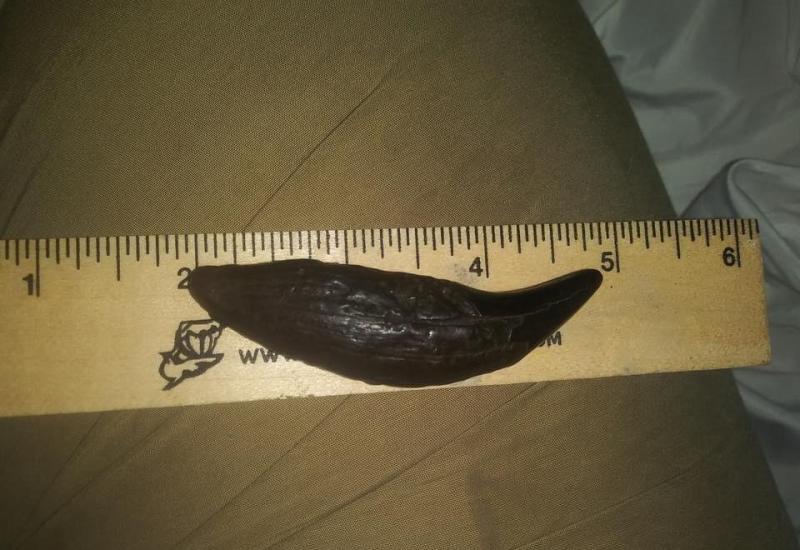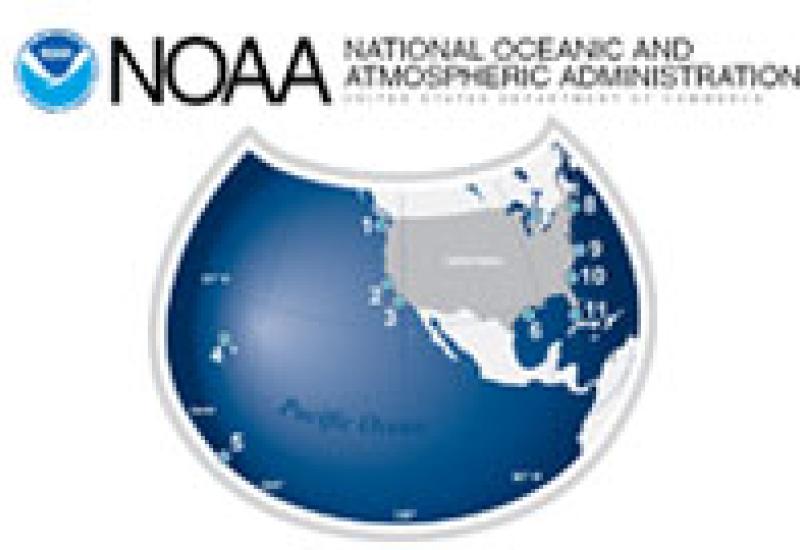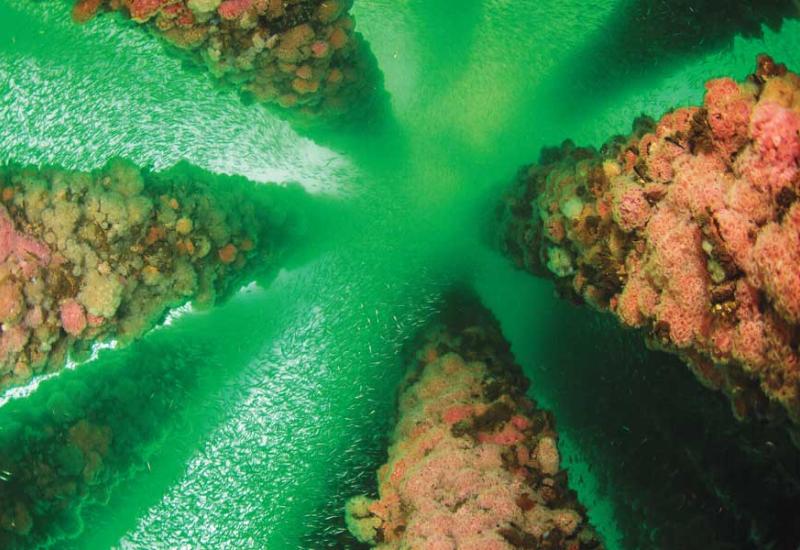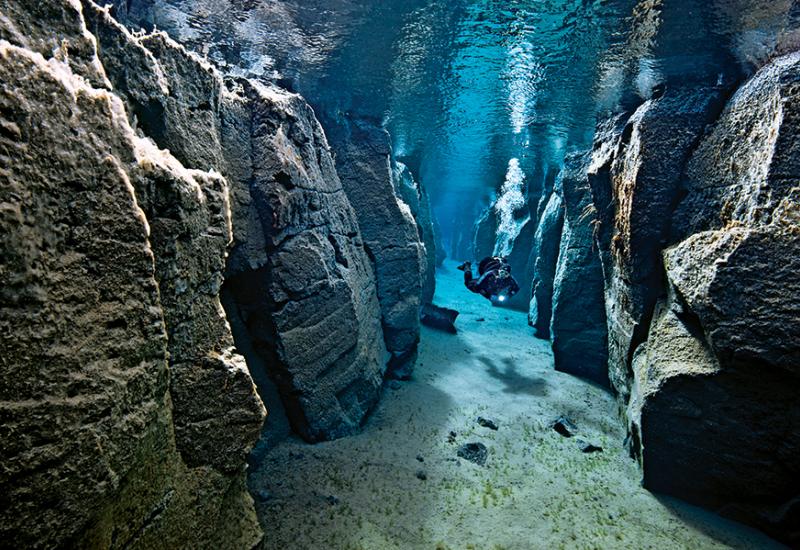The Texas Clipper
April 2008
By James Sturz
Her bent and broken white railings look like boiled fettuccine, twisted with chains and tied with ropes frayed into fans. And with nearly three dozen starboard openings, there's a dark abyss everywhere for me to duck into. At first, penetrating the 473-foot, 7,000-ton U.S.T.S. Texas Clipper, 17 nautical miles off the South Padre Island coast, feels like swimming through an obstacle course of giant rectangular entryways, cargo holds and staterooms. But the more I weave, the more it feels like swimming through a mammoth block of Swiss cheese.
With the Clipper on her side, sometimes she doesn't even look like a ship. There are horizontal ladders and davits resembling skeletal wings. But the most breathtaking part of my dives comes while exploring her B deck. Starting at about 65 feet, the deck is a dark canyon plunging straight down--an ominous wall in the blue fog of open sea. Then, rising beyond it, there's a field of what appear as giant white snowflakes. They're the size of propellers and are as startling and alien as anything I've seen underwater--more on these later.
Now, even as the Texas Parks and Wildlife Department and salvage contractor Resolve Marine Group hash out whether to right the ship, Texas's massive dive community is flocking to the state's southern tip to make the same eerie discoveries. Scuttled in November, she's the country's third-largest ship sunk as an artificial reef--and the largest outside of Florida. Before earning that distinction, the Clipper underwent a yearlong $4 million makeover in Brownsville, including hull modifications and the removal of 700 tons of metal and debris.
When Texas Parks and Wildlife finally arranged the Clipper's sinking after 10 years of wrangling, there wasn't a local diver who didn't hail it as a cause for celebration. But when the Clipper sank, she didn't plunge 134 feet straight down, as intended. Everything had been painstakingly planned for, except seven months of delays and high seas. The Clipper was pummeled by seven- to nine-foot waves, causing her to list. She flooded, and then toppled to her port side, at 90 degrees.
That's why while diving the Clipper, it's easy to make comparisons to the Spiegel Grove, in the Florida Keys, which started her own underwater life upside-down. But even on her side, there are plenty of intriguing semi-enclosed spaces to explore. Diving the ship's contours reveals ledges, curves, straightaways and overhangs. But it's enough to peer through her portholes to glimpse the ship's myriad previous lives.
Built by Bethlehem Steel in 1944, she was first named the U.S.S. Queens, after the New York City borough. Over six decades, she sailed some 1.3 million miles, including to Japan in World War II, where she was the first attack troop transport ship in Iwo Jima. Four years later, American Export Lines rechristened her the S.S. Excambion and ushered her into the tony world of ocean liners. (While navigating the promenade deck's aft end, where formal dances and dinners were held, I suddenly feel a strange need to slip on a pair of dress fins.) But the ship's playing hostess to high society ended in 1958, and the federal government reacquired her for its reserve fleet. After seven quiet years of anchorage on the Hudson River, the U.S. Maritime Administration then loaned her to Texas Maritime Academy, in Galveston, Texas, a precursor of Texas A&M University. For the next 30 years of her active life, as the U.S.T.S. Texas Clipper, she was a merchant marine training vessel for Texas A&M students, who once again sailed her around the globe.
That's why her hull, 66 feet below the surface, is Aggie maroon and white and reads "Texas A&M University at Galveston" in giant letters. At 80 feet, I swim past two brass plaques on the navigation deck, commemorating the Clipper's prior lives and her sinking. But while the Clipper is steeped in history, one part of what's happening on her today may influence the future of other vessels. For the first time, artificial reef modules have been installed on a ship. These white ceramic spools, which look like a garden of three-foot spiked ice crystals, are what I had thought looked like gargantuan snowflakes. But they're really part of an experiment to try and attract fish, even without live coral fragments.
But so far a lack of fish isn't a problem. Pinfish were spotted on the Clipper just 48 hours after her sinking. On my own dives, I easily see hundreds, plus a thick school of Atlantic spadefish and a lone sergeant major trying to blend in. The South Texas banks already attract dozens of reef and pelagic species, and Texas Parks and Wildlife expects many of them to come calling and the ship to be heavily encrusted by barnacles, clams, corals, sponges and mussels in her first year.
While slowly ascending from the Clipper, a lone jack passes me on the line, a hint of the expected new life. But as I kick toward the surface, it's hard not to look back at the ship, which has already lived so much.
InDepth
Getting Around: To reach South Padre Island from Houston by road, take U.S. 59 South, merge onto U.S. 77 South, and continue past Corpus Christi and Harlingen. Then follow Route 100 east through Port Isabel to South Padre Island, crossing the 2.5-mile Queen Isabella Causeway, the longest bridge in Texas.
Dive Conditions: Dive season is year-round, although March through October offers peak visibility of 80 to 100 feet, flat seas, and water temperatures from the mid-70s to mid-80s. In winter, water temperatures are in the high 60s and visibility is 50 feet; surface conditions are unpredictable at this time. Because of the Clipper's orientation, she's an intermediate to advanced dive, beginning at 66 feet and bottoming out at 134 feet.
Dive Outfitters, Charters and Education Centers: American Diving, www.divesouthpadre.com, offers trips from Sea Ranch Marina on South Padre Island. Deep Six Diving, www.deepsixpadre.com, sails from Port Isabel. For more on the Clipper's history and plans to right it, visit Texas Parks and Wildlife's site, or log on to www.texasclipper.org.
April 2008
By James Sturz
Her bent and broken white railings look like boiled fettuccine, twisted with chains and tied with ropes frayed into fans. And with nearly three dozen starboard openings, there's a dark abyss everywhere for me to duck into. At first, penetrating the 473-foot, 7,000-ton U.S.T.S. Texas Clipper, 17 nautical miles off the South Padre Island coast, feels like swimming through an obstacle course of giant rectangular entryways, cargo holds and staterooms. But the more I weave, the more it feels like swimming through a mammoth block of Swiss cheese.
With the Clipper on her side, sometimes she doesn't even look like a ship. There are horizontal ladders and davits resembling skeletal wings. But the most breathtaking part of my dives comes while exploring her B deck. Starting at about 65 feet, the deck is a dark canyon plunging straight down--an ominous wall in the blue fog of open sea. Then, rising beyond it, there's a field of what appear as giant white snowflakes. They're the size of propellers and are as startling and alien as anything I've seen underwater--more on these later.
Now, even as the Texas Parks and Wildlife Department and salvage contractor Resolve Marine Group hash out whether to right the ship, Texas's massive dive community is flocking to the state's southern tip to make the same eerie discoveries. Scuttled in November, she's the country's third-largest ship sunk as an artificial reef--and the largest outside of Florida. Before earning that distinction, the Clipper underwent a yearlong $4 million makeover in Brownsville, including hull modifications and the removal of 700 tons of metal and debris.
When Texas Parks and Wildlife finally arranged the Clipper's sinking after 10 years of wrangling, there wasn't a local diver who didn't hail it as a cause for celebration. But when the Clipper sank, she didn't plunge 134 feet straight down, as intended. Everything had been painstakingly planned for, except seven months of delays and high seas. The Clipper was pummeled by seven- to nine-foot waves, causing her to list. She flooded, and then toppled to her port side, at 90 degrees.
That's why while diving the Clipper, it's easy to make comparisons to the Spiegel Grove, in the Florida Keys, which started her own underwater life upside-down. But even on her side, there are plenty of intriguing semi-enclosed spaces to explore. Diving the ship's contours reveals ledges, curves, straightaways and overhangs. But it's enough to peer through her portholes to glimpse the ship's myriad previous lives.
Built by Bethlehem Steel in 1944, she was first named the U.S.S. Queens, after the New York City borough. Over six decades, she sailed some 1.3 million miles, including to Japan in World War II, where she was the first attack troop transport ship in Iwo Jima. Four years later, American Export Lines rechristened her the S.S. Excambion and ushered her into the tony world of ocean liners. (While navigating the promenade deck's aft end, where formal dances and dinners were held, I suddenly feel a strange need to slip on a pair of dress fins.) But the ship's playing hostess to high society ended in 1958, and the federal government reacquired her for its reserve fleet. After seven quiet years of anchorage on the Hudson River, the U.S. Maritime Administration then loaned her to Texas Maritime Academy, in Galveston, Texas, a precursor of Texas A&M University. For the next 30 years of her active life, as the U.S.T.S. Texas Clipper, she was a merchant marine training vessel for Texas A&M students, who once again sailed her around the globe.
That's why her hull, 66 feet below the surface, is Aggie maroon and white and reads "Texas A&M University at Galveston" in giant letters. At 80 feet, I swim past two brass plaques on the navigation deck, commemorating the Clipper's prior lives and her sinking. But while the Clipper is steeped in history, one part of what's happening on her today may influence the future of other vessels. For the first time, artificial reef modules have been installed on a ship. These white ceramic spools, which look like a garden of three-foot spiked ice crystals, are what I had thought looked like gargantuan snowflakes. But they're really part of an experiment to try and attract fish, even without live coral fragments.
But so far a lack of fish isn't a problem. Pinfish were spotted on the Clipper just 48 hours after her sinking. On my own dives, I easily see hundreds, plus a thick school of Atlantic spadefish and a lone sergeant major trying to blend in. The South Texas banks already attract dozens of reef and pelagic species, and Texas Parks and Wildlife expects many of them to come calling and the ship to be heavily encrusted by barnacles, clams, corals, sponges and mussels in her first year.
While slowly ascending from the Clipper, a lone jack passes me on the line, a hint of the expected new life. But as I kick toward the surface, it's hard not to look back at the ship, which has already lived so much.
InDepth
Getting Around: To reach South Padre Island from Houston by road, take U.S. 59 South, merge onto U.S. 77 South, and continue past Corpus Christi and Harlingen. Then follow Route 100 east through Port Isabel to South Padre Island, crossing the 2.5-mile Queen Isabella Causeway, the longest bridge in Texas.
Dive Conditions: Dive season is year-round, although March through October offers peak visibility of 80 to 100 feet, flat seas, and water temperatures from the mid-70s to mid-80s. In winter, water temperatures are in the high 60s and visibility is 50 feet; surface conditions are unpredictable at this time. Because of the Clipper's orientation, she's an intermediate to advanced dive, beginning at 66 feet and bottoming out at 134 feet.
Dive Outfitters, Charters and Education Centers: American Diving, www.divesouthpadre.com, offers trips from Sea Ranch Marina on South Padre Island. Deep Six Diving, www.deepsixpadre.com, sails from Port Isabel. For more on the Clipper's history and plans to right it, visit Texas Parks and Wildlife's site, or log on to www.texasclipper.org.










